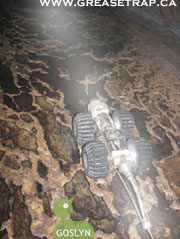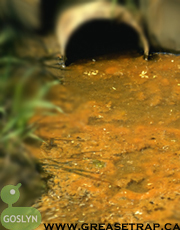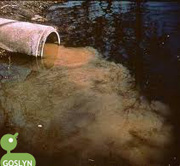The City of Richmond, British Columbia, spends over $300,000 annually on operations and maintenance to respond to grease accumulations in the sanitary sewer system.
Sanitary Sewer Overflows
When the sewer that transports human waste, wastewater and industrial liquids overflow onto the street, a raw sewage spill has occurred. This occurrence is called a sanitary sewer overflow. The acronym is SSO.
Restaurant Grease is estimated to account for 70% of sewer plant blockages and 30% of pump station failures by the US Environmental Protection Agency. The first step in solving the problem with FOG in our sanitary sewers is to educate the public on what problems are caused and what it costs when they dump their kitchen grease down the drain.
The City of Edmonton cleaned approximately 650 kilometres of both sanitary and combined sewers in 2007. The cost to clean the sewers was $1.2 million. 151 kilometres of Televised Drainage of the mainline sewer was an additional cost of $375,000. Fats, Oils, and Grease was present at a peak of 50% of the sewer lines.
In 2011, the City of Portland spent $12.1 million to clear sewer lines clogged from fats, oil and grease.
Passive Grease Traps and Interceptors
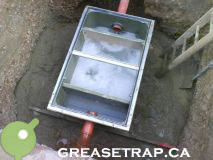
Standard grease traps or passive grease traps store fat, oil, grease, (FOG) and food solids for months on end. The rotting by-product is brown grease. Brown grease that collects in grease traps is too contaminated for recycling. The brown grease that bypasses the grease trap restricts the sanitary sewers fuctionality. Restaurant grease builds up, constrict the flow with grease blockages and inevitably the sewers overflow.
Remarkably, passive grease trap technology has not changed in the last century. The grease trap interceptor was patented by Nathaniel Whiting of California in the late 1800’s. Design codes for grease traps allow for an average efficiency of only 85% (grease interceptors - 60%) for a grease trap to be considered adequate. The enforcement of grease trap bylaws by municipalities is rapidly increasing. Passive Grease traps / interceptors are a large factor in the contamination of our sewers, and natural waterways.
When passive grease traps and grease interceptors are not maintained monthly, 40-60% of the restaurant grease bypasses the interceptor. The brown grease flows directly into the sanitary sewer. Grease traps at full capacity discharge 100% of the grease to the sanitary sewer. Unmaintained grease traps have no environmental benefit. Many Grease Trap Ordinances request that a standard grease trap or grease interceptors be emptied when 25% full of brown grease, but how can you tell? Passive grease traps and interceptors have no visual method of determining brown grease capacity. Many municipalities are requiring grease interceptor pumping every 30 days. The grease pumping expenses add up in a hurry.
A sanitary sewer worker in downtown Ottawa was asked if many of the sewer connection pipes had grease blockages. His response was "Yes, every one".
Brown grease inside a grease trap attracts cockroaches, fruit flies, mice, and rats from the sanitary sewer lines. An in-ground grease interceptor never receives thorough cleaning due to its size and location. A human being cannot get inside a grease interceptor with cleaning tools.
Annual Grease Cleanup costs are on average $3 million in San Francisco
Passive Grease Trap Systems are no longer accepted in San Francisco
Goslyn Grease Removal Devices (GRD) made the Preferred GRD list
Sanitary Sewers

Sanitary sewers transfer effluent or wastewater from a sink, drain, or toilet. (raw sewage) The wastewater from homes and businesses flows to treatment plants where cleaned and sanitized before being released into lakes and rivers, or reused for potable water. (drinking, bathing)
Restaurant grease adheres to the inside of pipes, collecting various debri and particles that eventually result in massive blockages. Grease blockages have been reported to be over 8 feet in length. (Boston, Massachusetts)
Sewers with grease blockages result in sanitary sewer overflows (SSO). Raw sewage backs up, overflows and is forced to the street, storm sewers, properties, and basements. Restaurant grease reduces the diameter of the piping in the sewer. Brown grease, Paper products and other debris help to completely block the sewer lines.
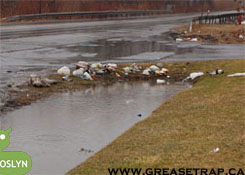
Raw sewage includes human waste, among several other pollutants. Bacteria and pathogens have detrimental effects to our health. Sanitary sewer overflows can result in numerous diseases. Raw Sewage cleanup requires proper management of sewage damage disposal which contain strains of gram-negative bacteria like E. coli and Salmonella. Professional contractors and city employees involved in the raw sewage cleanup are at risk of chronic illnesses. The exposure to allergens, endotoxins, chemicals and toxic gases are unavoidable. Public health, is at risk of disease brought by raw sewage from sanitary sewer overflows.
Carpets and furniture contacting raw sewage must be steam cleaned and sanitized.
Sanitary Sewer Repair Costs
Columbia, South Carolina spends approximately $1.5 million to clean up sanitary sewer overflows and grease stoppages annually.
Restaurant grease clings to the sewer pipes near restaurants. The grease must be scrubbed off the piping by public works crews. (On overtime pay) Restaurants must practice responsible grease management. When restaurant grease enters the sanitary sewer, the city repair and maintenance costs are needless and excessive. Sewer pipes, pumping stations, and sewage treatment plants are affected on a daily basis. Public works repair costs are funded by the taxpayer.
"Some of our lift stations, they dont look like a lift station. They look like a grease trap". The utility recently wrapped up a $1.7 million rehabilitation project in two of the citys main sewer basins, and those lines, only weeks old, are already starting to see grease buildup. "Our pump station was rated marginal. Overflow from grease traps is the cause." Kevin Anderson, Engineer - City of Monterey"
Storm Sewers
Storm sewers were designed to transfer rainwater and melted snow from city, residential and commercial properties directly to our natural fresh water systems.
Grease blockages, causing sanitary sewer overflows, discharge raw sewage and untreated waste into the storm sewer. The water in which we perform leisure activities is affected.
Grease blockages have become epidemic. California citys have implemented Sanitary Sewer Overflow reporting programs. Residents are asked to report sewer backups or overflows. The reporting procedure will reduce the impact to the environment and contain raw sewage spills before they reach a local waterway.
City of Toronto Sewer Bylaw
Municipal Code Chapter 681
Basic Requirement and Information for Restaurants
| Substance | Limit (mg/L) | Necessary Action |
| Oil & Grease (animal and vegetable) | 150 | Maintain the Grease Trap |
| Biological Oxygen Demand (BOD) | 300 | Prevent Solids from Entering the drain |
| Suspended Solids | 350 | Prevent Solids from Entering the drain |
The City of Toronto's Sewer Bylaw (municipal Code 681) controls the quality and quantity of substances discharged into the sanitary sewer and storm sewer system and natural watercourse:
The City of Toronto's Water Supply Bylaw (municipal Code 851) requires specific measures that will provide reliable metering information, improve operational efficiency and protect the integrity of the water supply system:
Any costs incurred by the City as a result of a grease-blocked sewer or damage to the sewers will be charged back to those responsible.

Preserving the Sanitary Sewers
Preserving the Environment
Preserving your Money



